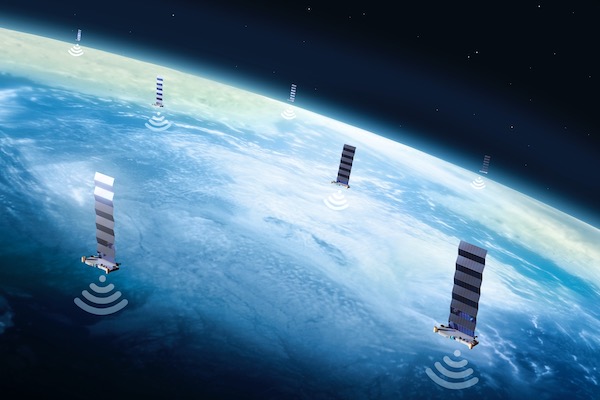Published on the 02/03/2023 | Written by Heather Wright

Starlink in NZ fastest in Oceania, AU 100+Mbps…
New Zealand’s Starlink performance has come out on top for Oceania, adding further impetus for the satellite offering already enjoying its time in the sun after Cyclone Gabrielle wiped out telecommunications across parts of the North Island.
But the news in the latest Ookla Speedtest report was a mixed bag. While New Zealand had the fastest median download speed among satellite providers in Oceania at 124.7Mbps, followed by Australia at 106.4Mbps, fixed broadband outperformed Starlink in New Zealand. In Australia, Starlink, which hit one million users globally in Q4 2022, outperformed fixed broadband providers.
“Cyclone Gabrielle exposed the frailties of New Zealand’s communications network.”
For comparison, in Europe Denmark and Switzerland led the pack for fastest median download speeds at 147.5Mbps and 136.0 Mbps respectively. In Japan where the service only launched late last year, Ookla says it’s seeing ‘promising 100+ Mbps speeds’ at 156.9Mbps.
But back to the Australian and New Zealand results: For both countries, Starlink was behind fixed broadband providers in median upload speeds, and multi-server latency was higher, though in New Zealand the latency – which Ookla dubs an increasingly important metric – was under 50ms. Ookla says that’s ‘a very exciting development’. Low latency is critical in enabling the seamless connected experiences we expect these days. A 2009 study reported that every 100ms of additional latency on Amazon.com lost the company one percent of revenue.
While New Zealand’s download speed was four percent faster in Q4 2022 than a year earlier, Australia’s speed was still significantly slower – down 24 percent year on year – despite a small increase in recent months.
That’s a problem being seen globally. Rapid increases in subscriber numbers dented the speed performance around the world of Elon Musk’s Starlink, and despite some modest rises in median download speeds in the past quarter, speeds are still down on 2021.
In New Zealand, Cyclone Gabrielle has put the focus back on telecommunications and the role satellite offerings such as Starlink can play, particularly in emergency situations.
Gabrielle exposed the frailties of New Zealand’s communications network when cell towers were knocked out of action, largely due to extended power cuts, with mobile, landline, internet connections and emergency 111 capability offline for extended periods.
As telcos rushed generators onto trucks, planes and helicopters in an effort to restore some communications links, eyes turned to the skies, with satellite options such as Starlink touted as one option.
Starlink units were deployed in affected areas, with some South Island councils providing theirs for affected Northern counterparts.
But Starlink also requires power. Dr Ulrich Speidel, senior lecturer in the University of Auckland School of Computer Science, says Starlink kits tend to be power hungry – around 80 to 100 watts –generally requiring a mains connection or generator.
Speidel notes too that satellite communication can, and often is, affected by storms when the signal path and antennas on the ground are affected or signals are attenuated by heavy rain.
The impact of wider usage is also a factor, Speidel notes, as has been seen with the global slowdown.
Increasing use could also come with increasing charges. In the United States, Starlink has warned of a US$10 increase in monthly charges from late April for areas where there is limited capacity, with a $20 decrease for areas where there is excess capacity.
Starlink has been available in New Zealand since March 2021, initially direct via the company.
Noel Leeming became Starlink’s first New Zealand retail partner last December, offering the hardware in-store and online, with telco 2degrees announcing last month that the devastation caused by Cyclone Gabrielle had caused it to fast track plans to offer Starlink Business satellite broadband. The telco opened registrations of interest last month, as well as making 10 enterprise grade devices available to emergency services to help with recovery efforts.
In Australia, the Sydney Morning Herald has reported that Starlink is closing in on 100,000 active users, just two years after launching there.
Of course, Starlink isn’t the only satellite option. Low earth orbit is an increasingly crowded space (just ask the astronomers gnashing their teeth over the satellites’ impact on observing and discovering the cosmos), with multiple competitors deploying major offensives.
Amazon’s Project Kuiper gained FCC approval last month to launch more than 3,200 satellites, expected to launch via Amazon founder Jeff Bezos’ Blue Origin. Ookla notes that holds potential threats for Starlink, given Amazon’s global reach, scale and consumer base.
Long-term satellite internet provider Viasat, which already has an A/NZ footprint through its defence force work, is also gearing up to launch its Viasat-3 arrays which aim to provide 100+ Mbps connections – a significant improvement for the mainly geostationary satellite orbit provider. APAC is the third of the satellites to launch, behind the Americas and EMEA with ViaSat saying the launch will be ‘approximately six months’ after EMEA’s September 2023 launch.
OneWeb is also expanding its network with a second batch of satellites due to launch early this month and expanded services ‘coming soon’ for Australia.
A range of local services, including Farmside and Wireless Nation in New Zealand, are also available across A/NZ.
Starlink and other satellite network providers are also in a race to provide global mobile phone service connections, with Starlink launching its BlueWalker 3 satellite, expected to provide satellite phone service to mobile phones rather than a dedicated handset, late last year. The company has partnered with US telco T-Mobile for a US-only limited service, the beta of which is expected to launch by the end of this year.



























